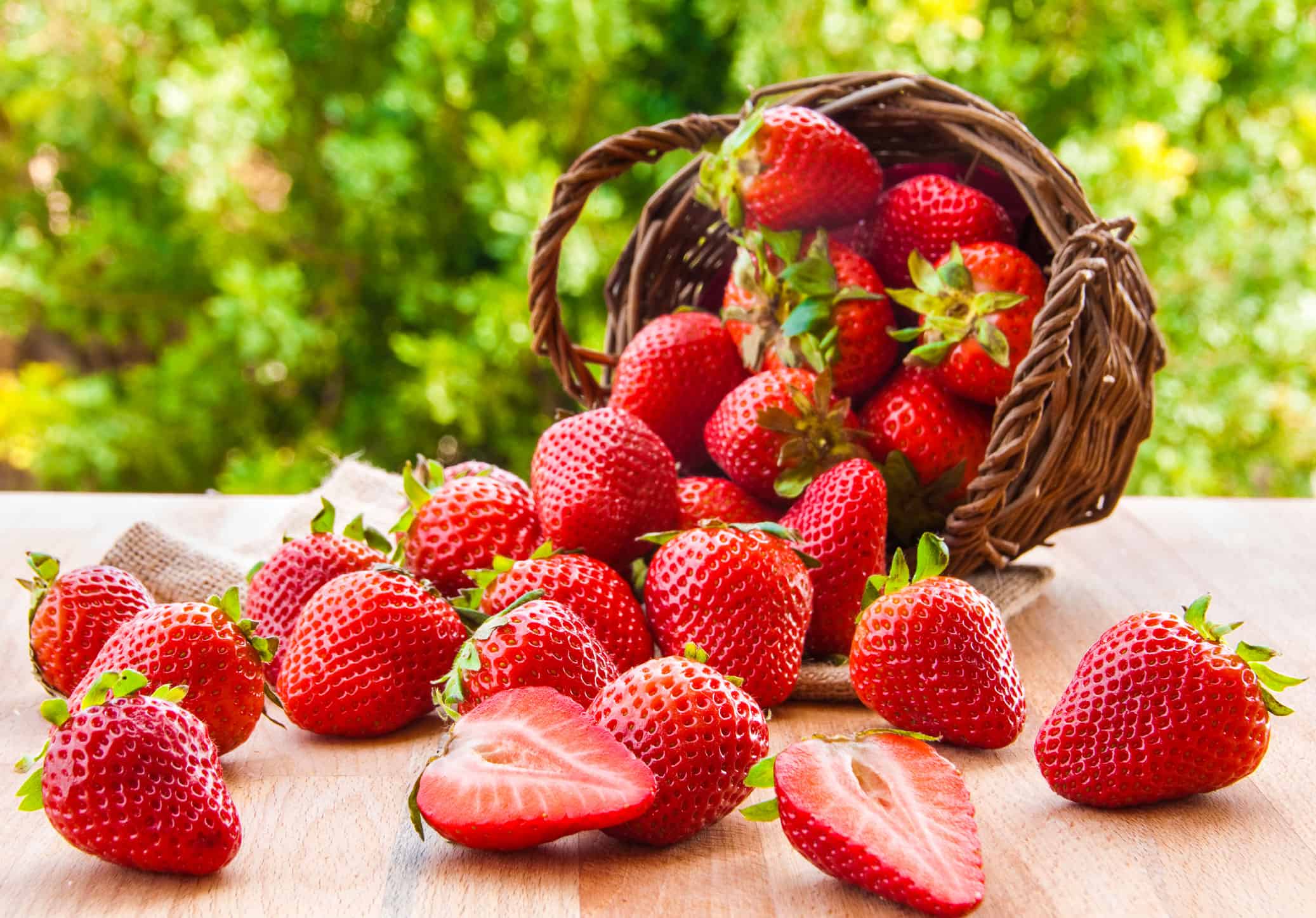Scientifically, tomatoes, eggplants, and even watermelons are berries. But ordinary folks know berries as pulpy, edible fruits, small enough to hold a number of them in your hand. These delectable treats are often sweet, though some are tart or sour. Here are everyone’s favorite berries!
1. Strawberries
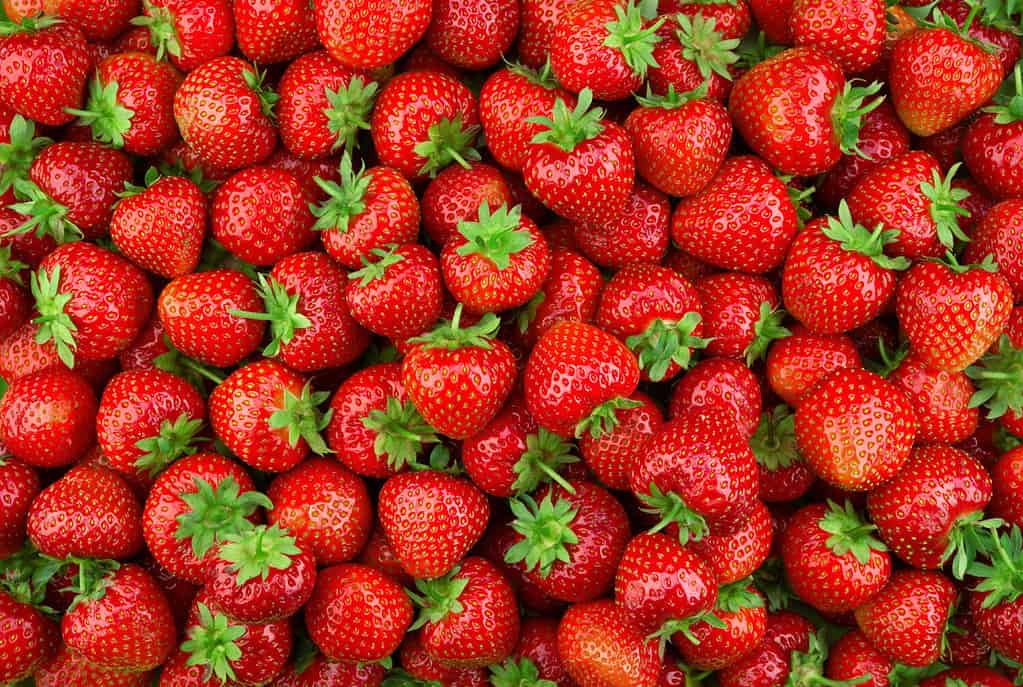
Strawberries are one of the most popular berries.
©MarcoFood/Shutterstock.com
Possibly the most popular of the berries, the garden strawberry belongs to the Fragaria genus. People love these fruits for their fragrance, sweet taste, and beauty. Strawberries were first domesticated from wild strawberries in France in the 1700s, though wild strawberries have been eaten since ancient times. They are rich in Vitamin C and manganese.
Purchase these berries when they’re plump and have a beautiful gloss to them. Don’t reject one because it is pale at the tip, as long as it still has its green frill. Wash the fruit right before hulling it. Some cooks believe you should never cook strawberries unless making jam.
2. Blueberries, Bilberries, Huckleberries

Blueberries freeze beautifully and can be enjoyed months after they’re picked.
©iStock.com/Nadya So
These berries are all member of the same genus, Vaccinium. Though bilberries are native to Europe, blueberries and huckleberries are native to North America. However, people now grow them in many places around the world. Some huckleberry species are members of the Gaylussacia genus.
Blueberries grow on shrubs that range in size from about 4 inches to 13 feet tall. They do best in soil that’ moist and acidic. Lowbush blueberries are wild, while highbush blueberries are cultivated.
A ripe blueberry is deep blue and covered with a bloom. These berries are sweet, but with a hint of acidity. Depending on where the bush is grown, the berry is ready to be picked from spring to late summer. Like strawberries, blueberries make great jams, jellies, and pies. Alternatively, toss them on breakfast cereals, bake them in muffins, or simply pop them directly in your mouth. As a bonus, they freeze beautifully, so you can keep them a long time. To keep them from sticking together, place the berries on a metal tray and place in the freezer. Afterwards, transfer them to a plastic bag. Blueberries are low in calories and high in dietary fiber and Vitamins C and K.
Bilberries look like blueberries, but they have a sort of crater at the bottom of the berry. They grow one or two at a time on the stem, while blueberries grow in clusters. They’re also a bit darker than blueberries and may look black, with red or purple pulp. The pulp of the blueberry is green.
A huckleberry can be blue, black, or red. Huckleberries love volcanic soil and even survived the eruption of Mount Saint Helens in 1980! They are similar to blueberries but may be a bit tarter.
3. Raspberries

When picking raspberries, the stem stays behind.
©iStock.com/billberryphotography
Raspberries belong to the Rubus genus and are related to the rose, as can be seen in the masses of white flowers that arrive in spring and give way to the fruit. A close relative of the blackberry, the two can be distinguished from each other by stems and color. When picking blackberries, the stem pulls away with the fruit, while with raspberries, it does not. This leaves a hole down the middle of the raspberry. Also, blackberries are purplish black. Raspberries can be yellow, purple, or red. There are even white raspberries, but they are highly perishable. Indeed, gardening experts recommend that the sooner you use a raspberry after it’s picked, the better.
Raspberries are also the source of the delicious liqueur framboise and easily hybridize with other members of the Rubus genus. This is why gardeners warn against planting raspberries and blackberries too close together.
Raspberries are tough plants and can thrive in hardiness zones 3 to 9. They’re often planted in the winter, when the canes are dormant. They need full sunlight and well-drained, fertile soil that’s slightly acidic to neutral. Raspberry plants can be aggressive and show up in the garden as weeds. Some people still welcome them because of the fruit. Raspberries are rich in Vitamin C, phytochemicals, dietary fiber, and manganese. Their leaves can be used in teas.
4. Blackberries and Dewberries
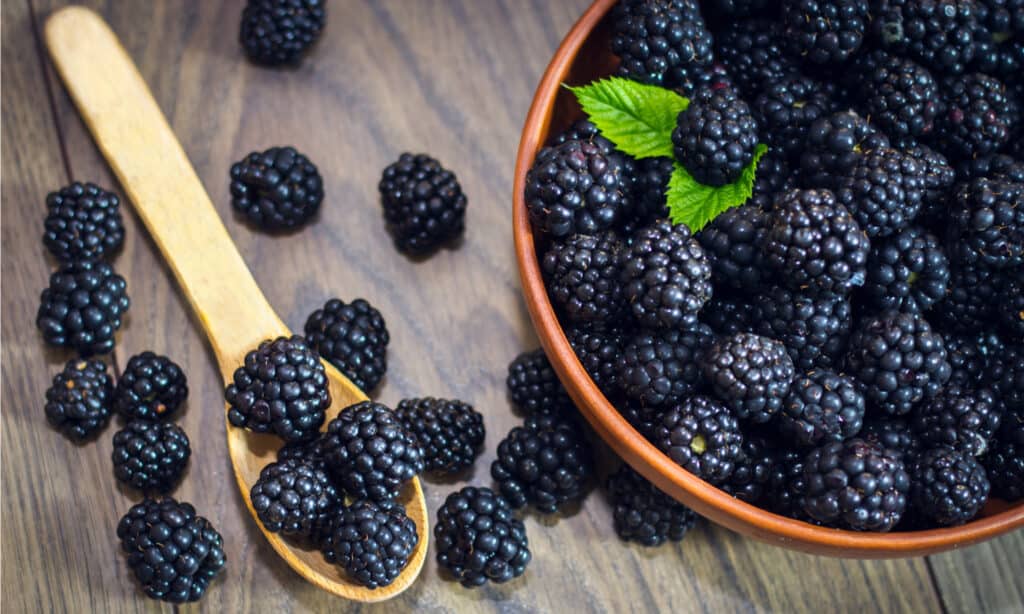
It takes a couple of years for a blackberry bush to produce its delicious fruit.
©Vipvit/Shutterstock.com
Humans have eaten this member of the Rubus genus for thousands of years. It is used in jellies, jams, pies, buckles, crumbles, crisps, and cobblers. It’s eaten out of hand and used to make blackberry brandy. Like its cousin the raspberry, the blackberry is high in Vitamin K and C, dietary fiber and manganese. Blackberries also have seeds that are high in omega 3 fatty acids. Some people find the seeds too annoying to enjoy desserts that feature blackberries.
It takes at least two years for a blackberry plant to start producing fruit. Its first year is spent growing a long cane called a primocane. This cane, which can be upright or trailing, can be as long as 30 feet. In the second year, the cane produces the plant’s beautiful white flowers and becomes a floricane. These floricanes produce fruit that can be challenging to pick if the blackberry plants are a thicket, for blackberries have serious prickles that can pierce clothing. Like the raspberry, the blackberry can be invasive.
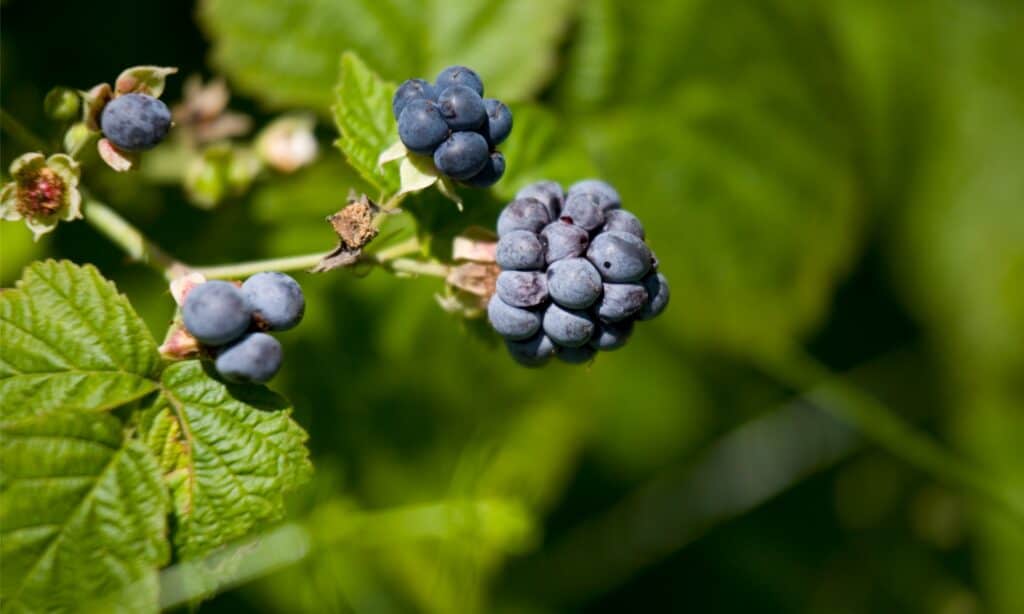
Dewberries resemble blackberries but are prostrate and lack the blackberry’s gloss.
©iStock.com/Bildvision_AB
Dewberries are like blackberries, but they trail along the ground, are smaller than blackberries and are dull as opposed to shiny like the blackberry. They are tricky to pick because they are delicate, but they’re sweet and have fewer seeds than blackberries. Because of this, people who object to the seediness of blackberries may enjoy desserts that feature dewberries.
Rubus Berry Crosses
These berries are crosses between other Rubus berries. Loganberries, developed by James Logan, are a cross between a raspberry and a blackberry, and the taste is tarter than the blackberry’s but milder than the raspberry’s. The Boysenberry, named for Rudolph Boysen, is a cross between the raspberry and the youngberry (the Youngberry, named for B.M. Young, is a cross between a dewberry, a blackberry, and a raspberry!) Another hybrid is the Tayberry, a cross between a red raspberry and a blackberry, named for Scotland’s River Tay.
5. Currants
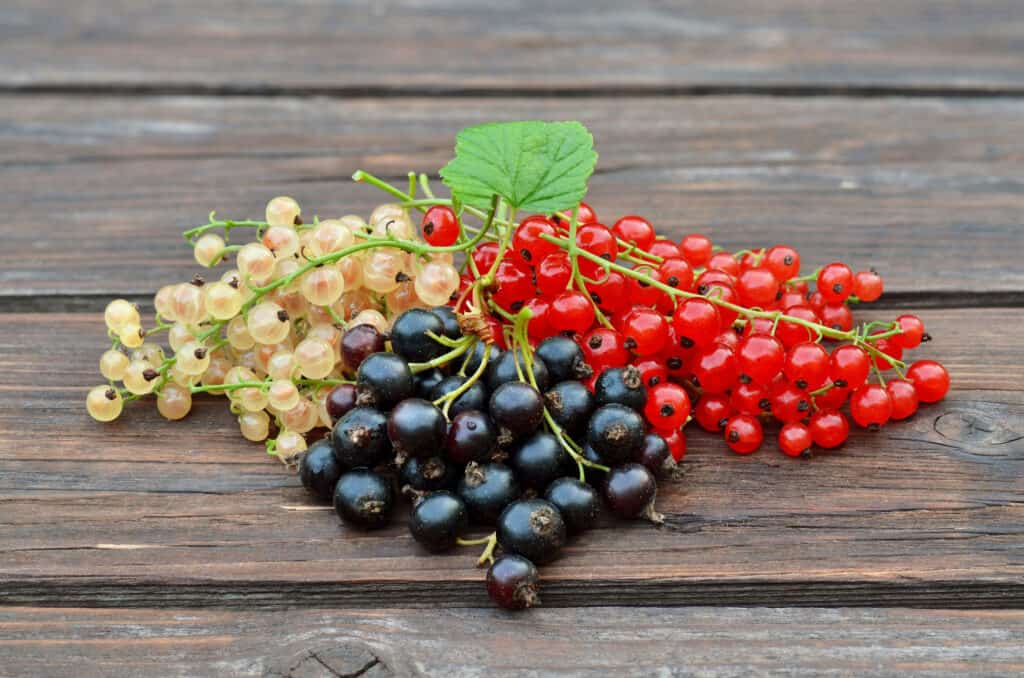
Another name for currants is cassis.
©iStock.com/Yuliia Bilousova
Currants belong to the Ribes genus, and they can be red, black, or white. They are found on deciduous shrubs and unlike the rose-like flowers of the Rubus fruits, their flowers are yellowish-green and not showy. Yet the berries hang on racemes like tiny grapes. Red currants are a bit tart and people who love them eat them with cream and sugar, turn them into jelly, compotes, or puddings or make them into Cumberland sauce. This sauce is poured over ham or venison during the holidays. Red currants are the key ingredient in Linzer torte.
The black currant shrub isn’t fussy about soil as long as it’s fertile and damp but not soggy. It can’t stand drought. The shrub is cold tolerant, but frosts can lower the yield of fruit. Another name for this fruit is cassis, and a liqueur of the name is made from it. It’s also made into purees, jams, and jellies. Because the black currant is tart, it is also used in savory dishes and often accompanies game and seafood.
The white currant is actually a pale cultivar of the red currant, and the taste of white currants is sweeter. Because of this, white currants are also eaten out of hand and are the main ingredient in Lorraine jelly. These currants prefer cooler climates and soil that’s a little acidic to neutral.
Currants are rich in Vitamin C and phytochemicals.
6. Gooseberries
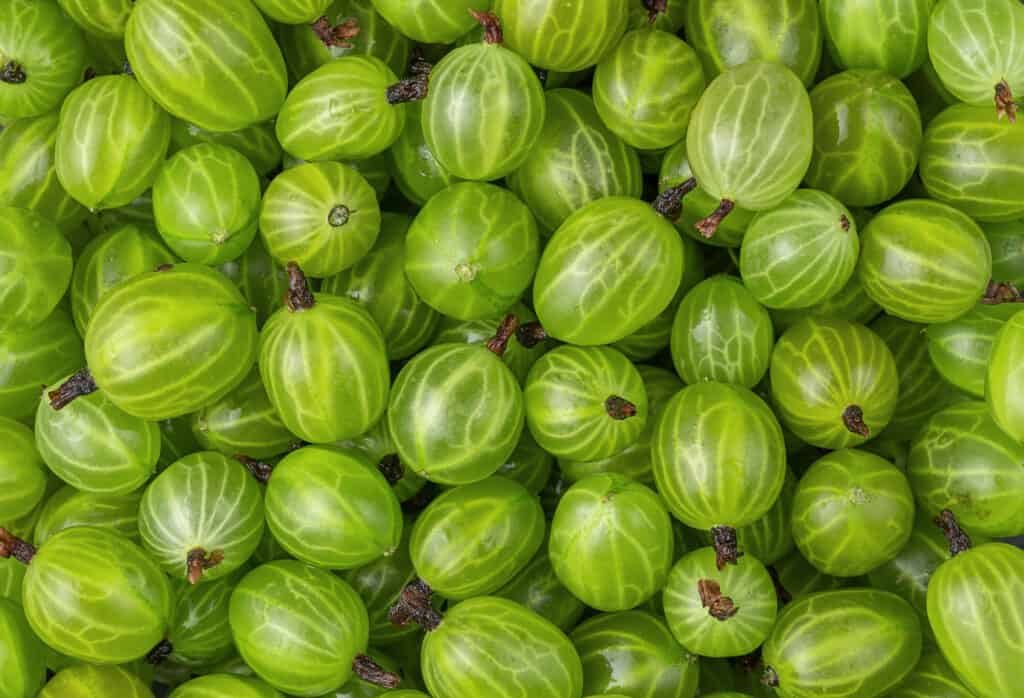
Gooseberries are close relatives of currants.
©iStock.com/Serhii Tychynskyi
It may surprise you to learn that gooseberries and currants are very closely related. They are both members of the Ribes genus. These berries appear as green, gold, orange, black, purple, or red balls. They can be translucent or have thick skin, they can be smooth or fuzzy. They have an advantage over nearly every other berry mentioned for they can be enjoyed when they’re still unripe. Indeed, they are best when they are just a bit sour and last longer when they’re picked a little early.
The gooseberry bush likes moist, fertile, well-drained soil. It flourishes in full sun, though it can stand some shade. It’s best to plant bushes in the early spring or fall. Mulch them and feed them with compost or rotted manure in the spring. The bush needs to be pruned to keep air circulating in the center and to simply make it easy to pick the berries, as gooseberry bushes have thorns.
Gooseberries are made into pies and famously used to make wine. They’re dried, pickled and turned into a syrup drizzled over apple pies.
7. Goji Berries
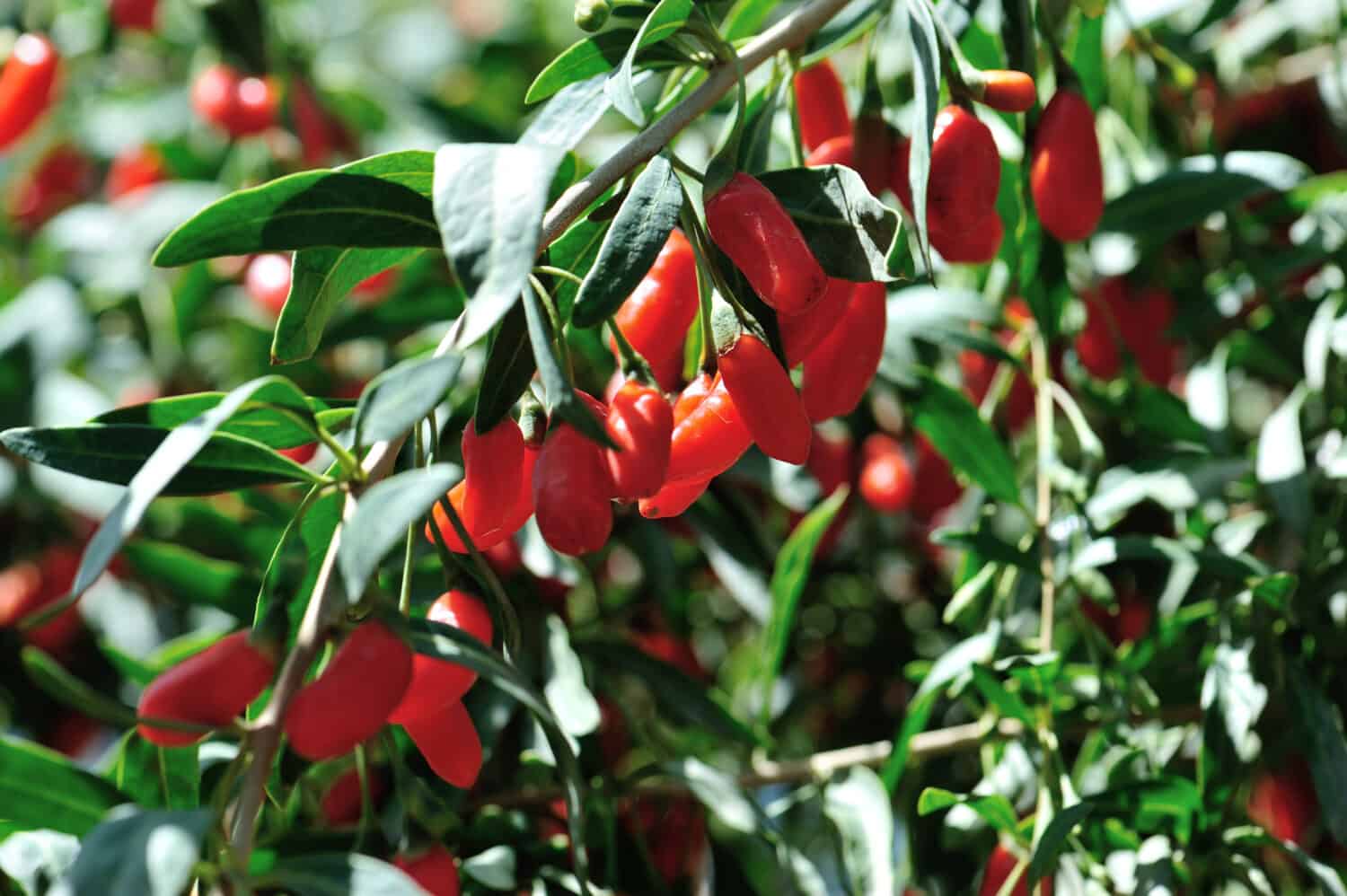
Goji berries are members of the nightshade family, but the young leaves and shoots are edible.
©lzf/Shutterstock.com
As members of the nightshade family, goji berries (of the Lycium genus) are relatives of the potato, tomato, and eggplant. However, unlike these other nightshades, the leaves and shoots of the goji berry are edible. Native to Asia, these berries are used both in cuisine and in traditional medicine. It’s also called the wolfberry due to Lycium‘s similarity to the Greek word for wolf.
The berry grows on bushes that grow from 3 to 12 feet tall. They do best in full sun and soil that’s a bit alkaline. Avoid acid soils and clayey soils that don’t drain well. You can grow goji berry bushes from seed, but you’ll have better luck if you start with a plant. The bush produces pretty purple, green, or cream flowers in the spring, and about a month later, the fruits appear.
The goji berry is said to have rather fantastical health benefits. There’s even a legend that a Chinese man who ate goji berries every day lived to be 256. But there’s no evidence that goji berries have unusual health benefits. It’s simply a good fruit to eat! Most goji berries you’ll find in the stores are dried and sold like raisins.
8. Cloudberries
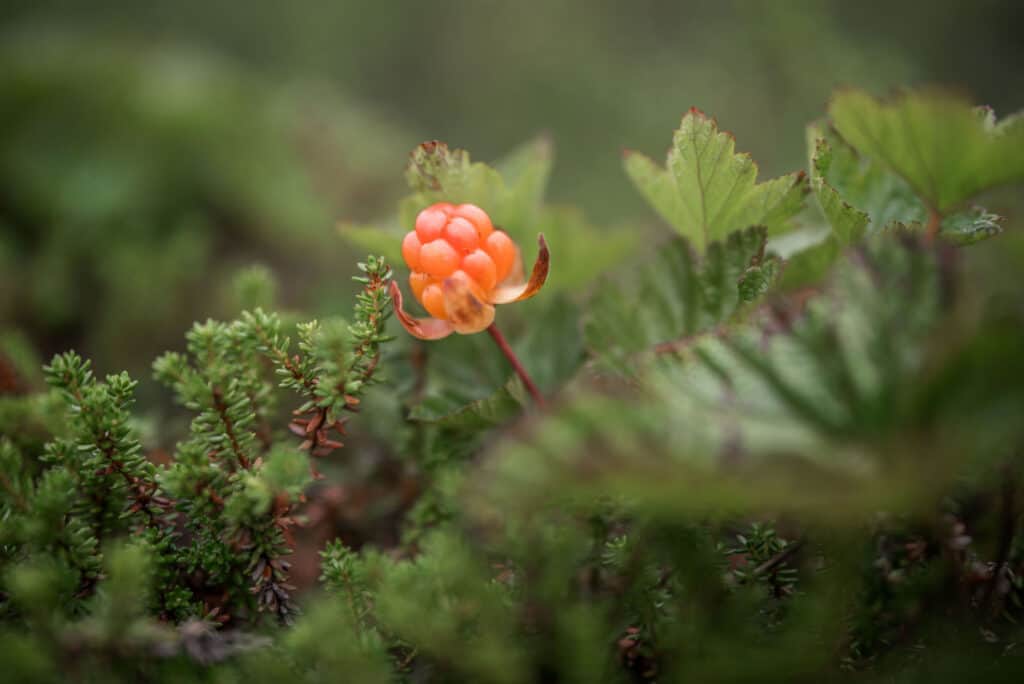
Though they’re popular types of berries in Scandinavia, cloudberries are not farmed but collected in the wild.
©Zboratskaya_foto/Shutterstock.com
Another member of the Rubus genus, cloudberries grow in the same places as the lingonberry. They are found as far north as the Arctic Circle. The cloudberry is unusual for a member of its genus in that it’s dioecious. This means that a male plant and a female plant need to be placed near each other for berries to be produced.
The cloudberry plant is a ground cover that grows between 4 and 10 inches high. It produces white flowers that give way to fruit that resembles a pale red raspberry. The fruit turns amber in the fall. The ripe cloudberry is tart, but when it’s allowed to slightly overripen, it turns sweet and creamy. Cloudberries are made into jams and tarts and mixed with sugar and whipped cream. They’re also added to yogurt and ice cream and are made into liqueurs. Cloudberries are high in Vitamin C and carotenoids. Carotenoids are precursors of Vitamin A and give the fruit its amber color.
9. Lingonberries
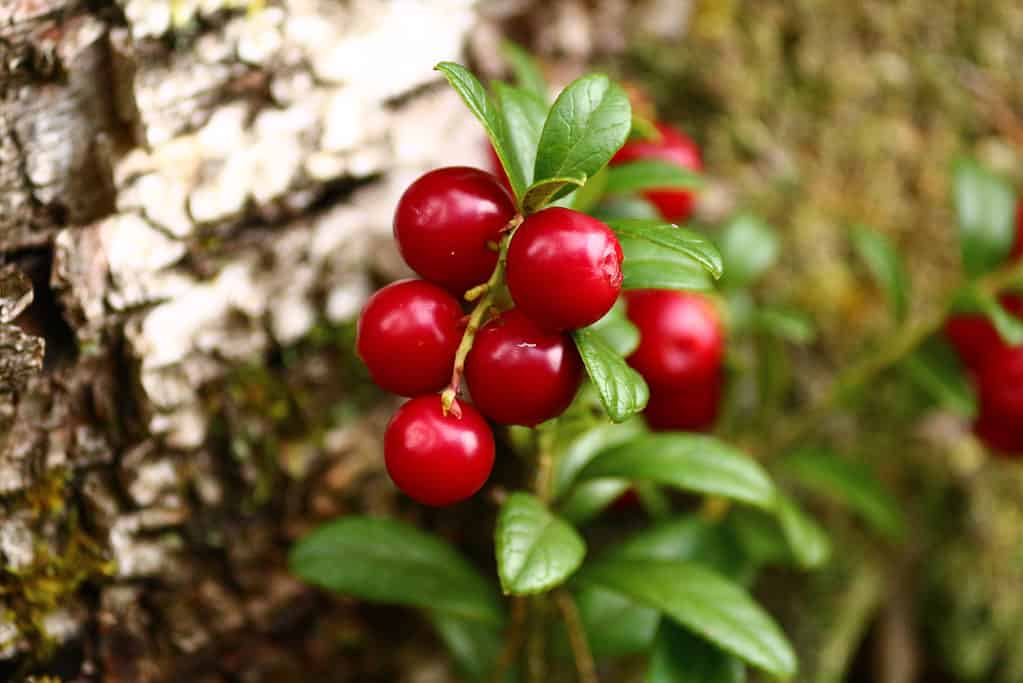
These popular berries are related to blueberries.
©iStock.com/Svetlana Sinichkina
These berries are members of the Vaccinium genus, which means they’re related to blueberries. Found in the colder parts of the Northern Hemisphere, they’re especially popular in the Scandinavian countries. Like the blueberry, the bush produces bell or urn-shaped flowers. They eventually give way to a tart red berry that is ripe by autumn. The berries grow sweeter if they’re left on the bush through the winter.
Lingonberries are used to make jams, juices and syrups, but since they’re tart, they’re often mixed with sugar. In Scandinavia, lingonberry is served with game.
The lingonberry bush is an evergreen and holds on to its leaves even as temperatures drop as low as – 40 degrees Fahrenheit, though a blanket of snow usually protects it. Though the bush is tough, it doesn’t do well in hot climates. It does best in part shade and in poor but not alkaline soils.
10. Cranberries
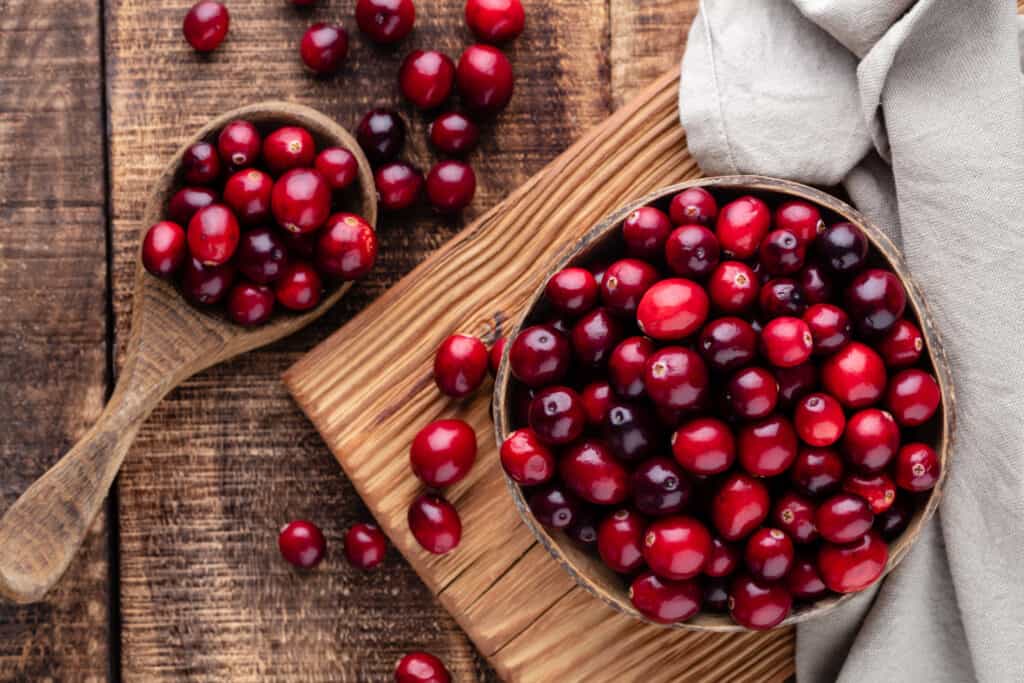
Most cranberries are grown and harvested in bogs.
©iStock.com/gitusik
The cranberry is also a member of the genus Vaccinium. Some botanists place it in the subgenus Oxycoccus or believe that Oxycoccus is its own genus. Cranberries famously grow in bogs in cool climates, and nearly all of them come from Canada, the United States and Chile. They’re made into juice and jam and the cranberry sauce served at Thanksgiving and Christmas. Cranberries are also dried and eaten out of hand. Bog cranberries are tart, while highbush cranberries are sweet. They are moderately high in Vitamin C, manganese, and dietary fiber.
Cranberries grow on prostrate evergreen shrubs or vines that can be 7 feet long but only 2 to 8 inches high. The leaves are tiny, and the stems are thin. The flowers are magenta with petals that curl all the way back to expose the stamens and style. The fruit, which grows bigger than the leaves, starts out green then turns deep red. Harvesting cranberries is labor intensive. It usually involves flooding the beds, taking the fruit off the vines with a harvester, then moving the floating berries to one corner of the bed and pumping them out.
11. Elderberries
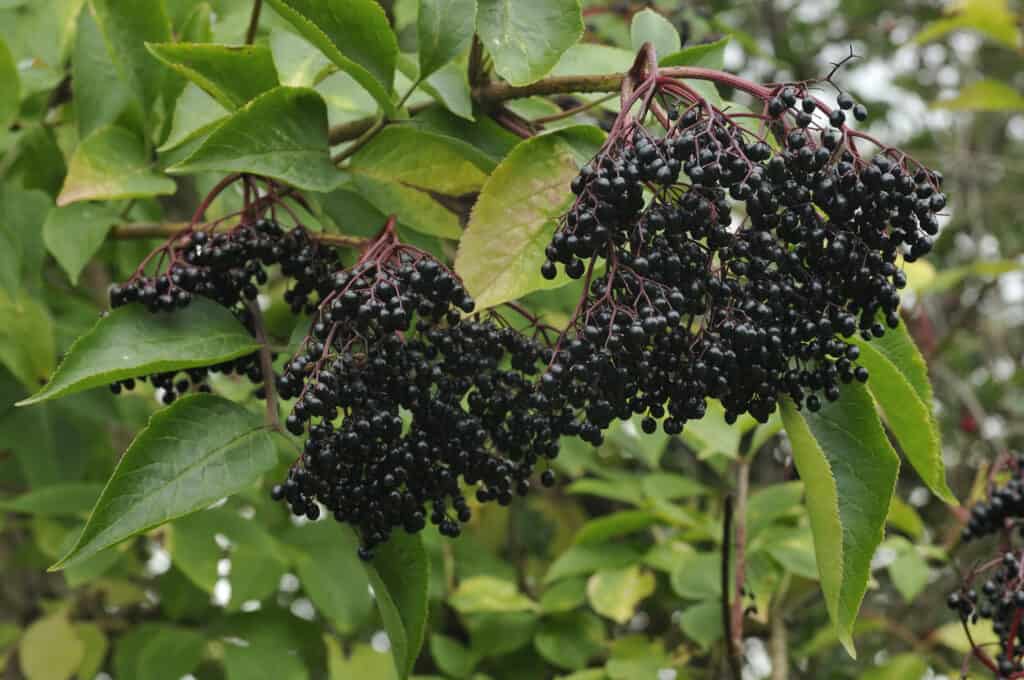
The elder tree not only produces fruit but beautiful, fragrant flowers.
©Martin Fowler/Shutterstock.com
Elderberries belong to the Sambucus family, and its flowers are famously used for fruit wine and a liqueur called St-Germain. The purple fruit is not only eaten but used as a dye. The berries grow in clusters on tree that can grow to 30 feet tall but has a shrubby habit. It takes between two to three years before it starts to bear fruit though the tree grows very quickly. When it’s ready, the tree erupts in fragrant white flowers that turn into fruit in the fall. Unlike the other berries described here, elderberries shouldn’t be eaten raw because they’re poisonous. They’re not only poisonous to humans but to dogs and cats as well. The other parts of the tree are toxic as well.
The tree is quite tough and flourishes in hardiness zones 3 to 9 and isn’t finicky about soil as long as it’s kept moist but well-drained. It does best in an open space that gets full sun. As with gooseberries, elderberries can be cooked into a syrup and served with apple pie. The tree itself is simply beautiful when it’s in flower, and some people dip the flowers in batter and fry them up as snacks.
Thank you for reading! Have some feedback for us? Contact the AZ Animals editorial team.

